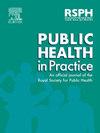Recruitment and retention of Chinese men at high risk for lung Cancer: Lessons learned from a pilot trial of a community health worker intervention to increase lung cancer screening uptake
IF 1.9
Q2 PUBLIC, ENVIRONMENTAL & OCCUPATIONAL HEALTH
引用次数: 0
Abstract
Background
The U.S. Preventive Services Task Force (USPSTF) currently recommends annual lung cancer screening (LCS) with low-dose computed tomography (LDCT) for asymptomatic 50- to 80-year-old adults with a 20-pack year history who currently smoke or have quit smoking within the past 15 years. Foreign-born Chinese livery drivers are a group at disproportionately high risk for lung cancer due to high smoking prevalence and occupational exposure to airborne contaminants and carcinogens. This paper describes a pilot randomized controlled trial to educate and navigate high-risk, previously unscreened Chinese livery drivers to lung cancer screening, and describes barriers to recruitment and retention.
Study design
Pre-pilot and pilot randomized controlled trial.
Methods
The study was conducted in two phases, a pre-pilot and pilot randomized controlled trial between December 2019 and June 2023. In the pilot RCT, eligible participants were randomized to either (1) the CHW (Community Health Worker) intervention group or (2) a written materials only control group and participated for 6–12 months.
Results
From December 2019 to June 2023, 25 subjects were enrolled: 12 in Phase 1 and 13 in Phase 2 (of 1018 approached). Recruitment barriers included the COVID-19 pandemic, institutional mistrust, smoking-related beliefs, and primary care provider-related barriers.
Conclusions
We identified specific socioenvironmental and cultural barriers to LCS uptake among Chinese immigrant men who smoke. Farther upstream cancer education interventions (e.g., provider and community-level education initiatives on LCS) conducted in partnership with community-based organizations should be considered to meet the needs of this population.
招募和保留中国肺癌高危男性:从社区卫生工作者干预增加肺癌筛查吸收的试点试验中获得的经验教训
背景:美国预防服务工作组(USPSTF)目前建议对50- 80岁无症状、吸烟史20年或在过去15年内戒烟的成年人每年进行低剂量计算机断层扫描(LDCT)肺癌筛查(LCS)。由于高吸烟率和职业暴露于空气污染物和致癌物中,外国出生的中国出租车司机是一个不成比例的肺癌高风险群体。本文描述了一项试点随机对照试验,旨在教育和引导高风险、以前未接受筛查的中国出租车司机进行肺癌筛查,并描述了招募和保留的障碍。研究设计预试验和中试验随机对照试验。方法2019年12月至2023年6月,本研究分为预试点和试点随机对照试验两个阶段。在试验RCT中,符合条件的参与者被随机分为(1)CHW(社区卫生工作者)干预组或(2)仅提供书面材料的对照组,参与6-12个月。结果2019年12月至2023年6月,共纳入25名受试者:一期12人,二期13人(共1018人)。招聘障碍包括COVID-19大流行、机构不信任、与吸烟有关的信仰以及与初级保健提供者有关的障碍。结论:我们确定了吸烟的中国移民男性接受LCS的特定社会环境和文化障碍。应考虑与社区组织合作开展更上游的癌症教育干预措施(例如,提供者和社区一级关于LCS的教育举措),以满足这一人群的需求。
本文章由计算机程序翻译,如有差异,请以英文原文为准。
求助全文
约1分钟内获得全文
求助全文

 求助内容:
求助内容: 应助结果提醒方式:
应助结果提醒方式:


